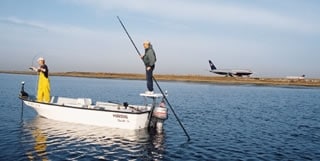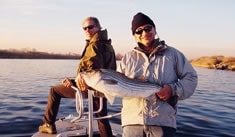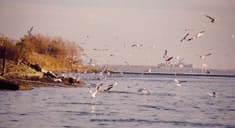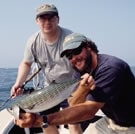
| A fly fisherman and his guide work the Jamaica Bay flats for early-season striped bass as a commercial airliner taxis for takeoff at nearby JFK airport. |
It’s 10:00 on a Monday morning and the tide is flooding the surrounding marsh shallows with clear water. Robin climbs onto the poling platform and cleans his sunglasses with the bottom of his shirt before pushing off with a quiet grunt. As Robin poles us toward the edge of the marsh grass, I make my way to the bow and pull off 60 feet of fly line, keen with anticipation as I scan the water.
“There’s one,” Robin whispers. “Ten o’clock, moving to 12 . . . Holy moley, look behind!” A group of ten large shadows leisurely moves in our direction. A fin momentarily parts the surface as one of the fish dips to feed. My heart pounds and beads of sweat form on my forehead.

Stripers often patrol the edge of the bay’s marsh banks, hunting for grass shrimp and other tidbits. Here, a well-placed popper draws a strike.|
“What are you waiting for? Cast!” Robin hisses. I raise my rod, but before I can make a false cast there is a deafening roar and the fish scatter, creating a commotion that startles several nearby seagulls. Robin groans in frustration as a huge jet thunders down a runway just a few hundred feet from where we float. We can only watch helplessly as dozens of fish spook off the flat in every direction.
“Wow,” says Robin from the platform, silhouetted against the Manhattan skyline. “Sensory overload!”
Urban Oasis
Anglers who fish the flats of Jamaica Bay, in the shadow of New York City, have learned to deal with such distractions, and the rewards are worth it. Encompassing approximately 10,000 acres of salt marsh and located less than ten miles southeast of one of the most densely populated cities in the world, Jamaica Bay is an extraordinary place. Since it was made a national park in 1972, the bay has been cleaned up dramatically, and now produces some of the best shallow-water action with striped bass, bluefish and weakfish on the East Coast.

When menhaden begin to show in the bay, larger bass aren’t far behind.|
Approximately 9,000 acres of the park is designated as a wildlife refuge and serves as a popular destination for birdwatchers and other nature lovers. Shore birds and raptors frequent the marsh, and Jamaica Bay boasts the largest population of diamondback terrapins – a rare estuarine turtle – in the world. The fact that such a vibrant marsh ecosystem exists so close to Manhattan is nothing short of astonishing.
Productive fishing begins around the second or third week in April. Once the water temperature reaches the high 40s and low 50s, the marsh begins to fill with grass shrimp. This is one of the most exciting times to fish the bay. The water clarity is not great, but you can have a blast casting to boils, swirls and finning stripers in two to four feet of water. Better still, the fish are usually ravenous after a winter of inactivity. Best fishing comes on high tides that flood the marsh grass.
Small flies resembling the size and color of the grass shrimp are, for the most part, useless when there are so many real shrimp in the water. The odds of getting such a tiny offering noticed by the fish are slim. Instead, small poppers are the way to go. Making a commotion in the vicinity of an aggressive striper will usually provoke a strike. Note that stripers often smack a popper with their tail a few times before eating it, so resist the urge to set the hook until you are sure the fish has inhaled the lure.
Stripers and Weaks

Peter McCarthy displays a nice striper that fell for a chartreuse popping bug fished along the edge of the marsh grass.|
Once May rolls around, sand eels and spearing (silversides) begin to enter the bay. This is when light-tackle striper fishermen focus on the ten- to 15-foot humps surrounded by deeper water. Productive lures include three-inch Slug-Gos or Bass Assassins in white, pearl or chartreuse, rigged on 1/2- to 3/4-ounce jigs.
For fly fishermen, small sand-eel and silverside patterns will work, but large Deceivers or Half-and-Halfs in white or chartreuse often take more and bigger fish. The water is still very murky in May, so the object is to get the fly noticed rather than to “match the hatch.” Bait can be so thick in this area that a bigger offering often draws more strikes than one that resembles the prevailing forage. Sinking lines in the 350- to 450-grain range are best for getting the fly down to the strike zone.
Around the second week of May, adult menhaden, locally called “bunker,” begin to arrive in Jamaica Bay. These baitfish measure eight to 14 inches long and attract big predators. Menhaden school in large numbers just below the surface and are easy to spot; look for the telltale “flip” of individual fish or large patches of riffled water to find them.
Often, big bluefish will attack bunker near the surface while monster bass in the 30-pound range lurk beneath, picking up the scraps. For light-tackle spin fishermen, the Storm Bunker Shad is the best lure to use when menhaden are present. Large, flashy, gold spoons fished slowly under the schools can be effective as well.

Juvenile menhaden flood the marsh in late summer and fall, and can be easily imitated with a variety of flies.|
Fly fishermen wishing to score a trophy should fish bulky flies in the eight- to ten-inch range, tied with a lot of material. Sinking lines in the 450-grain-plus range are necessary, not only for getting the fly down to the fish, but to improve castability. It can be very hard to cast a hefty fly on an intermediate or floating line. Once the fly is allowed to sink for a good while, retrieve it with a few hard, long strips. Because large bluefish are likely to be present, it’s a good idea to tie on a short wire tippet ahead of the fly.
It’s important to note that not every school of menhaden will hold stripers and blues. Large pods of undisturbed, “happy” bunker are better off ignored. Instead, look for small, tightly packed schools that appear “nervous.” Several bunker leaping clear of the surface is a sure sign that something large is trying to eat them!
Stripers in the Shallows

Schools of ravenous stripers often trap peanut bunker against the shallow shoreline, sparking fantastic action. When the fish are this frenzied, almost any type of plug, jig, spoon or fly will draw a strike. |
During late May and early June, water clarity in the bay improves dramatically, allowing anglers to sight-fish for stripers and big bluefish in the shallows. The latter often laze on the surface with the tip of their tail fins poking above the water. Big blues can be very skittish in the shallows, but will pounce on a fly or small plug that’s presented quietly and retrieved past their noses.
Stripers also patrol the bay’s expansive marsh flats. On sunny days you can often see the fish themselves, but during overcast conditions look for vee-wakes or tailing fish. Most of the fish are in the 24- to 30-inch range, but I’ve seen many larger bass in the shallows. However, getting them to eat can be very hard. As far as I can tell, the primary bait on the flats is spearing, but I’ve found that the stripers will eat nothing but crab patterns and tiny jigs dragged across the bottom.
In July, small “cocktail” bluefish provide most of the action inside the bay, although some bigger blues may be found among the remaining schools of bunker. In the early-morning hours, pods of blitzing schoolie bass can be spotted, but the action usually dies once the sun comes up.

Bonito usually make an appearance at the mouth of the bay around the end of July. The duration of their visit varies from year to year, but they may be available for several weeks.|
Toward the end of the month, bonito begin to show at the mouth of the bay. How long they stick around is anyone’s guess, but the action can last several weeks.
Big Blues on the Bar
In mid-August, finger mullet begin to occupy the bars just outside the mouth of the bay, attracting the attention of very large bluefish. A popper tossed among the breaking surf at this time can produce spectacular strikes. The bigger the swells, the better the fishing. However, it takes an experienced boat handler to fish the surf, so use extreme caution and always have someone at the helm.
Late August marks the arrival of false albacore around the mouth of the bay. They never venture much past the Marine Parkway Bridge, and when they come inside the bay they can be very hard to hook. Bay anchovy and juvenile menhaden flies, or small metal spoons such as the Deadly Dick or Swedish Pimple, are the best lures for these speedsters. But more important than fly or lure choice is the ability to use the wind and tide to get within range of the breaking fish. These fish are a bit more skittish than those found in the open water, so be sure to turn your engine off as you approach the school. False albacore usually stick around well into October, but September is by far the best month to chase them.
Striper fishing turns on again in late September and early October, when bass join the bluefish in chasing mullet on the bars near the mouth of the bay. From there, the stripers make their way into the marshes, where they usually find large amounts of juvenile menhaden (peanut bunker) to feed on. The bass will often drive schools of the little bunker into shallow water, creating some awesome sight-fishing opportunities.
|||| |—|—|—| |### Jamaica Bay Guides| Only two guides fish Jamaica Bay throughout the season. They are:Captain Ralph Burtis, Brooklyn, NY; (516) 887-2784; capralph@optonline.net.Captain John McMurray, Rockaway, NY; (718) 757-7339; onemorecast@prodigy.net.Captain Brendan McCarthy fishes the bay in spring and in late November and December. Call him at (917) 847-9576, check out his website at www.mctrout.com or e-mail him at mctrout@nyc.rr.com.Fin Chaser Charters occasionally makes the 45-minute run from Staten Island if the action is exceptionally good. Contact them at (917) 468-4817 or by e-mail at finfly@aol.com.
The striper action remains pretty consistent through November, but seems to peak during the last week and a half of October. Bucktail jigs in chartreuse or white in the 3/4-ounce range are probably the most effective and most frequently used lures. Many anglers swear by attention-getting Rat-L-Traps, which happen to have the same profile as the peanut bunker. For surface-feeding fish, I’ve found that 3/4-ounce Gags Grabbers in the menhaden pattern are the best choice. Popper and slider flies also work well, and provoke exciting strikes.
December can be one of the best months for taking trophy stripers, depending on the weather and the timing of the Atlantic herring run. These baitfish range from eight to 14 inches, and the bass that prey on them are big and hungry!
For the whole month of December of 2001, because of unseasonably nice weather, the herring run and the striped bass migration happened to coincide perfectly. There were days when fly and light-tackle fishermen scored with dozens of fish over 20 pounds. However, weather is most definitely a factor in this late-season fishery, and cold and windy conditions can really put a damper on the action. The best advice is to watch the weather and fishing reports and be ready to go at a moment’s notice.
No matter what time of year you visit Jamaica Bay, it only takes one trip to discover its unique beauty. When the sun sets over the Manhattan skyline to the northwest, it paints a picture that contrasts the extremes of human development and the natural beauty of the marshes. As it turns out, there’s room for both.
|||| |—|—|—| |### Regs & Tips| New York’s striper season opens May 8 and closes December 15. However, catch-and-release is permitted throughout the year. The minimum size is 28 inches.The New York State Department of Health recommends that no one should eat more than one meal per week (eight ounces) of striped bass taken from Jamaica Bay. Women of childbearing age and children under the age of 15 should eat no striped bass taken from the upper and lower bays of New York Harbor. Others are warned not to eat more than one meal per month of fish taken from this area.









